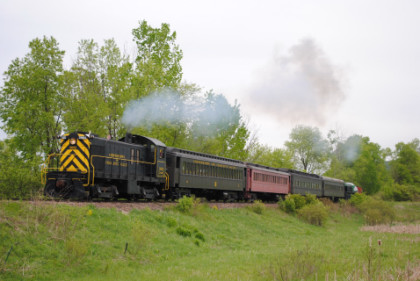
Randy and I arose after 6:30 AM and I worked on the story until we left the Red Carpet Inn and drove to Milford, stopping at MacDonald's to get breakfast to go then drove to the Milford station.
The TrainThe station in Milford erected in 1869 as 20' x 70' wood frame building with a combination of freight and passenger facilities for the Cooperstown and Susquehanna Valley Railroad. The Leatherstorkcing Railway Historical Society acquired the building and renovated it several years ago. Today, the station's waiting room and station agent's office have been renovated to look as they did in the 1800's.
Cooperstown & Charlotte Valley Railroad S-4 3051, nee Canadian National 8181 built by Montreal Locomotive Works in 1956.
The train in front of the station which consisted of Cooperstown & Charlotte Valley Railroad S-4 3051, coaches 101 and 103, lounge concession 233, coach 503, Delaware and Hudson open car 13843 and Delaware and Hudson caboose 35723. I then decided to explore.
Coopersville and Charlotte Valley Jordan spreader 35056, nee Delaware and Hudson 35056, built by O.F. Jordan in 1956, behind the engine shop.
Cooperstown & Charlotte Valley Railroad S-4 3052, nee Canadian National 8223 built by Montreal Locomotive Works in 1957.
Delaware & Hudson wreck crane 30021, nee Delaware and Hudson 30021 built by Industrial Works in 1926.
The track to Cooperstown Junction.
Yard scene.
An unidentified box car.
Delaware and Hudson wooden coach 294, built circa 1870. It is one of the oldest pieces of former D&H rolling stock still in existence today. The shingled siding comes from this car's use as a private residence in nearby Maryland, New York for many years before donation to the Leatherstocking Chapter NRHS.
Delaware & Hudson caboose 35796, nee Reading 94115 built by International Car in 1971.
Erie caboose C316 built by International Car in 1953.
An unidentified wooden caboose.
Track equipment in front of the engine house.
A Brief HistoryIn 1869, the Cooperstown & Susquehanna Railroad was built as a six foot gauge line to connect Cooperstown with the Albany & Susquehanna Railroad, a predecessor to the Delaware & Hudson Railway. In 1876 the line was rebuilt to a standard gauge line. In 1888 the Cooperstown & Charlotte Valley Railroad was organized to build from Cooperstown Junction eastward across the Catskill Mountains in competition with the then building Delaware and Ulster Railroad. The first action was leasing the Cooperstown & Susquehanna Railroad. The railroad wanted to build north towards Fort Plains but was stopped when some land owners would not sell. In 1903, the Delaware and Hudson Railroad acquired the railroad for $112,500 and renamed it the Cooperstown Branch. In 1930, the trackage south of Cooperstown Junction was abandoned. In 1937, passenger serviced ended on the branch. In 1970, freight traffic was gone and the D&H applied to abandon the rest of the line.
In April 1971, the D&H sold the branch to the Delaware Ostego Corporation which operated both freight and passenger trains from Cooperstown Junction to Cooperstown under the Cooperstown & Charlotte Valley Railroad name {CACV}. Excursion with steam ended in 1975 and diesel passenger trips lasted until the mid 1980's. The CACV final freight run operated in December 1987. In July 1997 the line change ownership one last time when the Leatherstocking Railway Historical Society of the National Railway Historical Society purchased the railroad. Excursion passenger trains began again on July 6, 1999 operating between Milford and Cooperstown.
Our Train TripThe train departed on time.
A pond to the west of the tracks.
Rolling north into the countryside.
A farm with a flea market.
A view heading north.
R on this side of the post.
W on this side of the post.
Views from both sides of our train.
A pond on the east side of the train.
We would be following the Susquehanna River north to Cooperstown.
We detrained for the first photo runby of the day with this view.
Photo Runby 1.
The reverse move.
Delaware and Hudson Milepost C6. We all reboarded and proceeded to our next photo location at the Baseball Dream Park.
The Baseball Dream Park station where everyone detrained.
The reverse move, after which I relocated under the bridge.

The photo runby at the Baseball Dream Park
The train reversed to pick us up and we all reboarded.
View of the Baseball Dream Park.
Team housing.